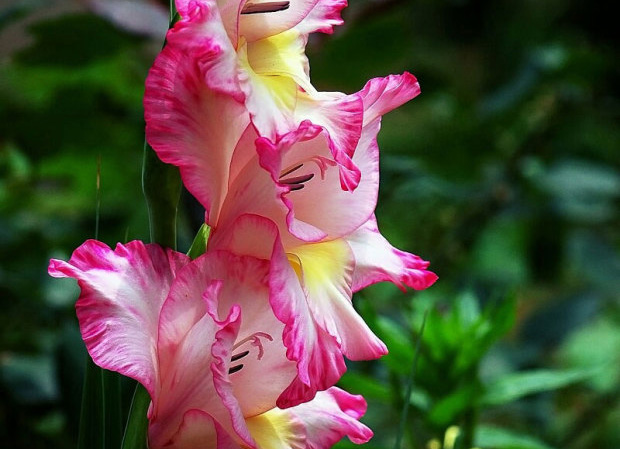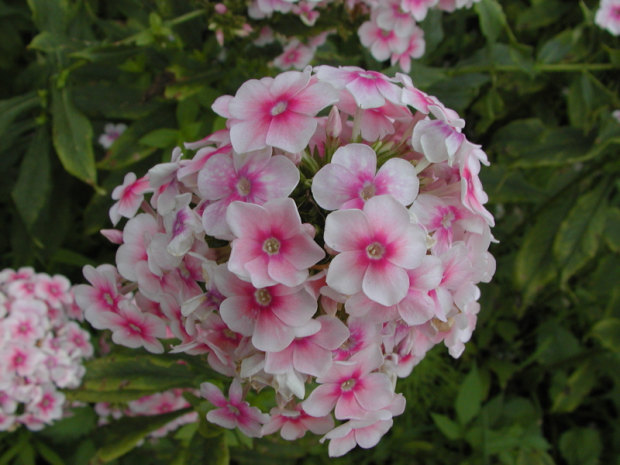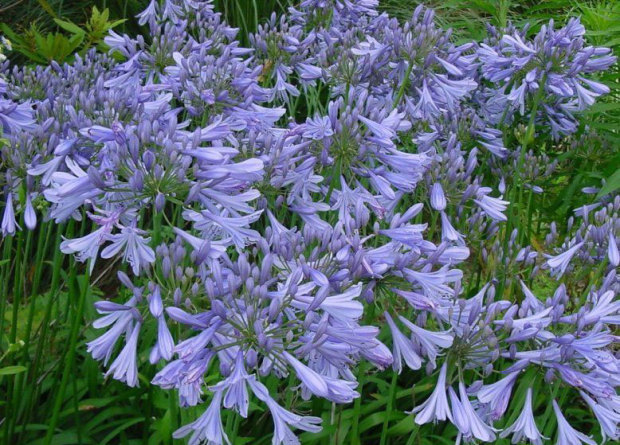Cultivation and Management methods of Gladiolus
"the sword leaves are like calamus, the long stems are drawn, they are full of bone pods, and all kinds of funnel-shaped flowers bloom one by one. People like to cut off the flower stems and insert them in a vase. If they leave the roots, the flowers should be placed straight to the top." This is a portrayal of the basic characteristics of Gladiolus. Its aliases are: calamus orchid, sword orchid, assorted variety, 13 Taibao, flat bamboo lotus and so on. The underground part of Gladiolus is oblate-shaped corm, each corm has a central main bud and two side buds, a strong corm, in every growing season, in addition to the main flower stem, sometimes can also pull out 1 color two lateral flower stems. The inflorescence of Gladiolus is long and straight, with more than 20 flowers per flower, which can continue to watch flowers for more than a week; large flowers, colorful varieties, varied flower shapes, high ornamental value, easy cultivation and reproduction, it is the most popular cut flower for family flower lovers, and it is also the most important cut flower in flower production in the world. Gladiolus is a bulb flower of Iridaceae. Originated in South Africa, a few in the Mediterranean coast of southern Europe and West Asia and other places, about 250 wild species, mainly distributed in the Cape of good Hope in South Africa.

Around 1740, Gladiolus was introduced from South Africa to Europe and cross breeding began. At present, the varieties cultivated are all hybridized, eliminated and selected between different species, and the number of varieties is more than 8,000. Basically, it can be divided into two categories: spring flowers and summer flowers. Spring flowers are planted in autumn in warm areas and blossom in the following spring, while summer flowers are planted in spring and bloom in summer. Summer flower species can be divided according to the length of the growth period: early flowers bloom in 50 to 70 days. The middle flower blossoms in 70 to 90 days and the late flower blossoms in 90 to 120 days. Summer flowers are cultivated in North China, and the flowering period is from June to October. The cultivation and management method of Gladiolus "the sword leaf is like calamus, the long stem is drawn, it is full of bone pods, and all kinds of funnel-shaped flowers bloom one by one. People like to cut off the flower stem and insert it in a vase, leaving the root, and the flower should be placed straight to the top." This is a portrayal of the basic characteristics of Gladiolus. Its aliases are: calamus orchid, sword orchid, assorted variety, 13 Taibao, flat bamboo lotus and so on. The underground part of Gladiolus is oblate-shaped corm, each corm has a central main bud and two side buds, a strong corm, in every growing season, in addition to the main flower stem, sometimes can also pull out 1 color two lateral flower stems. The inflorescence of Gladiolus is long and straight, with more than 20 flowers per flower, which can continue to watch flowers for more than a week; large flowers, colorful varieties, varied flower shapes, high ornamental value, easy cultivation and reproduction, it is the most popular cut flower for family flower lovers, and it is also the most important cut flower in flower production in the world. Gladiolus is a bulb flower of Iridaceae. Originated in South Africa, a few in the Mediterranean coast of southern Europe and West Asia and other places, about 250 wild species, mainly distributed in the Cape of good Hope in South Africa. The corm of Gladiolus can sprout at 4 Mel 5 degrees and grow best at 20 Mel 25 degrees, which requires sufficient sunshine, good ventilation and good environmental conditions to avoid muggy and cold and wet soil, so it is better to grow in summer in Northeast and North China than in Central and East China, avoiding cold and waterlogging. Every year, the new ball is formed above the cue ball, and the cue ball gradually decays with the growth of the new ball, and the condition of large temperature difference between day and night is conducive to the maturity of the new ball. It can usually be harvested one month after flowering. The method of dividing balls is mainly used for reproduction. Courtyard cultivation in North China can be planted in batches in early April, and no later than late July, flowers continue to bloom throughout summer and autumn, while balls planted in the first and middle of July blossom on National Day. In addition to planting big balls, small balls can also blossom within two years; they can also be propagated by cutting bulbs, each with a strong bud, and the incisions are smeared with plant ash to prevent decay and have a certain fertilizer effect. In the cultivation of new varieties, the application of seed reproduction, sowing and seedling management properly can blossom within two years. The depth of corm planting depends on the nature of the soil and the size of the bulb, about 510 cm, the big ball is deeper, the small ball is shallow, the sandy soil should be deep, and the clayey soil should be shallow. The distance between plants and rows varies from about 1525 cm. Gladiolus should be cultivated in the courtyard with sunny and well-drained topography, and the general garden soil can be planted, but the fertile sandy loam containing humus is the most suitable. It can also grow and blossom in clay, but the development of the renewal ball is poor, and the number of small balls formed under the old ball is also less. Before planting, the soil should apply enough base fertilizer, and the type of base fertilizer is suitable for those rich in phosphorus and potassium fertilizer. After planting, it should be watered in time, and the soil should be kept moist and loose. Carefully managed plants should also be applied topdressing three times, but nitrogen fertilizer should not be too much, otherwise the plant growth is poor and flowering is delayed. The time of topdressing was applied for the first time after the first and second leaves to promote the growth of stems and leaves, the second time to promote the development and opening of flowers when the stems and leaves elongated and pregnant with buds, and the third time to promote the development of regeneration bulbs after flowering. For the purpose of cutting flowers, it is appropriate to cut the first flower at the base of the inflorescence, and when cutting the flower stem, keep as many leaves as possible on the plant, so that there are enough leaves to provide sufficient nutrition for the renewal bulb. it is best to insert slender scissors into the center of the leaf, cut the flower stem and damage the leaf as little as possible, and cut the flower stem at least more than four leaves for simplicity. The best time for cut flowers is every morning. The flowers inserted into the bottle will bloom upward in order every day, and the first flowers will wilt in turn. The wilted flowers should be removed every morning, and the pedicels should be cut properly, so that the length of inflorescences and pedicels should be kept in proportion to the bottle, and the bottle of water should be changed, so that the beautiful ornamental value will not be lost from beginning to end. Generally speaking, a bunch of flower arrangement can keep watching flowers for about a week, about 5 days in summer and 12 days in winter. If the purpose is to harvest the bulb, pick the bud and leave the stem when the bud is colored, so as not to consume nutrients due to flowering and be disadvantageous to the growth of the bulb. When planting flowers in the courtyard, the pedicels should be cut off under the first flower after flowering, so as to avoid setting seeds and consume nutrients. When the temperature drops in September and October, plant growth slows down, and watering should be controlled; between October and November, when the leaves are yellow, cut off the stems and leaves about 5 centimeters above the ground, dig out the balls, dry them in the shade, or dry them in the sun, and guard against Rain Water and dew on rainy days and at night. After harvest, in wet and rainy areas, it is best to have air-drying equipment, the temperature can be maintained at 30 degrees, dry the surface of the ball as soon as possible to avoid infection. When digging the ball, you should choose a sunny day, be careful not to damage the small ball, and remove the residue of the old ball at the base of the new ball in time, and remove the old root, clean the corm skin, but do not peel. Eliminate balls with diseases and insects and deal with large and small balls separately. The big ball can be placed in a flat-bottomed perforated sieve, and a small amount of available gauze can be bagged. It can be stored in a well-ventilated condition of 4mi 11 degrees, and 2mi 3 degrees is the most ideal. In the process of cultivation, the diseases and insect pests of Gladiolus are more serious. The common diseases are ball rot, dry rot and scab, which are mostly caused by high temperature or humidity during storage. In addition, mosaic virus is caused by aphids, which causes the plant to wither. Rotation planting in the process of cultivation can reduce the occurrence of the disease, prevent the disease ball under the ground, and reduce the spread of the disease. When possible, before planting the bulb, use 1/1000 carbendazim, add 1.8/1000 carbendazim or thiram, the water temperature is 46 degrees, soak the seed ball for 15 minutes and rinse with clean water for 10 minutes, spread out and set aside, can be used for planting. Gladiolus is very sensitive to the poisonous gas hydrogen fluoride and can be used as an indicator plant for monitoring hydrogen fluoride in the air. Its bulb can be used as medicine to treat bloated inflammation, carbuncle and other diseases. Cultivation and management of Gladiolus Gladiolus is the king of cut flowers in the world, its cultivation management should pay attention to the following points.
1. Methods of reproduction
It is mainly propagated by dividing balls. Take off the natural ball and seed ball from the cue ball and plant them in the field. Those with large bulbs can blossom in one year, and small bulbs (less than 1 cm in diameter) can blossom after 1 or 2 years of culture. In the case of few balls, cutting balls can be carried out in order to accelerate reproduction. Because the biennial gladiolus ball usually has 4 or 6 bud eyes, which are generally arranged in a straight line, the seed ball can be longitudinally cut into several parts, each part must have more than 1 bud and part of the stem disk, otherwise it can not sprout and root. In order to prevent decay, the part of the incision should be smeared with plant ash and then planted after the incision is dry.
2. Management measures
The sandy soil with warm, moist, sunny, well ventilated and good drainage should be selected (pH value is 5.5-6.5). Fully mature organic fertilizer and phosphorus and potassium fertilizer should be applied when planting in late March (soil temperature is higher than 5 ℃). Because the application of phosphorus fertilizer can improve the quality of flowers, potassium fertilizer can improve the quality of bulbs and the number of bulbs. The bulbs need to be disinfected before planting. Soak them with 50% carbendazim 500 times solution for 20 minutes and then plant them after drying. When planting, it was planted according to the size of the bulb, and the planting depth was 2-3 times that of the bulb. It can be watered once after sowing.
Gladiolus corms can blossom only after a certain period of dormancy after harvest. In order to prolong the viewing period, the annual supply of cut flowers can be planted in batches according to the length of the growing period (mostly 80-90 days): for example, if planted in the greenhouse from January to February, "May Day" can provide flowers; transplanting from the greenhouse to the open field in March, "June 1" can provide flowers; if flowers are provided on National Day, you need to choose medium-sized balls for open-field shade planting in early July, water them in the morning and evening two weeks later, and see light in half of the sprouts. Planting in the greenhouse in September, you can supply flowers before and after New Year's Day, but you need to see light for 4 hours a day from the middle of October; in January, large bulbs are planted in the greenhouse, which can supply flowers before and after the Spring Festival, but the bulbs need to be fully refrigerated and begin to heat and replenish light around November. As Gladiolus is a typical long-sunshine flower, the flower bud can differentiate only when the light is as long as 14 hours. Therefore, controlling the florescence of Gladiolus needs to be carried out in an environment that can control light and temperature, and 0.2% potassium dihydrogen phosphate solution should be sprayed every 10 days during flowering. When cutting the cut flowers of Gladiolus, on the premise of meeting the length of the cut flowers, each plant should retain at least 4-5 leaves to promote the continuous growth of the underground corm. When the leaves turn yellow, harvest bulbs can be excavated and stored in a cool and ventilated room after drying for a week. The bulbs delayed planting in the second year should be stored at low temperature (2-3 ℃) to avoid germination and deterioration.
3. Pest control
The common diseases and insect pests of Gladiolus include blight, mosaic, brown spot, corm rot and nematode disease. Rhizoctonia solani is mainly caused by excessive watering, high temperature and poor ventilation, which can be irrigated around the roots with 50% Dysenamine solution 300: 500 times. Mosaic disease and brown spot can be sprayed with 65% Dysen zinc 600 times solution. Corm rot mostly occurs during storage because of high temperature or high humidity. Keeping dry and cool environment can prevent infection. The nematode disease was sprayed with 40% dimethoate emulsion 1000-1500 times.
The latest information
Cultivation techniques and application of marigold several measures for dwarfing cultivation of flowers
Hydroponic Flowers cater to consumption Fashion Medicinal and Health effects of Aloe Vera
- Prev

Culture and cultivation management methods of Fulukao
The hydrangea flowers are in full bloom and the summer flowers are in full bloom to welcome the autumn, which is the charm of the peach blossom season cultivated in the courtyard in our country. It is a perennial perennial herbaceous flower, so it is also called perennial root Fluke. The height of the plant is about 50ml / 80cm and the diameter of the floret is about 2.
- Next

Cultivation and culture methods of Baizi orchid (Baizi lotus)
Baizi orchid gets its name because of its many flowers and seeds, and its leaves are close to orchid, so it is also called purple orchid because its posture is close to that of gentleman orchid, but it is also called purple orchid; Shanghai, Hangzhou and other Jiangnan areas are also called Baizilian. Perennial evergreen rhizomatous herbs, leaves banded, ca. 80 cm long, basal, arranged in two rows
Related
- Fuxing push coffee new agricultural production and marketing class: lack of small-scale processing plants
- Jujube rice field leisure farm deep ploughing Yilan for five years to create a space for organic food and play
- Nongyu Farm-A trial of organic papaya for brave women with advanced technology
- Four points for attention in the prevention and control of diseases and insect pests of edible fungi
- How to add nutrient solution to Edible Fungi
- Is there any good way to control edible fungus mites?
- Open Inoculation Technology of Edible Fungi
- Is there any clever way to use fertilizer for edible fungus in winter?
- What agents are used to kill the pathogens of edible fungi in the mushroom shed?
- Rapid drying of Edible Fungi

